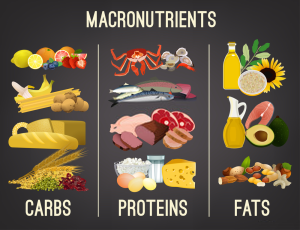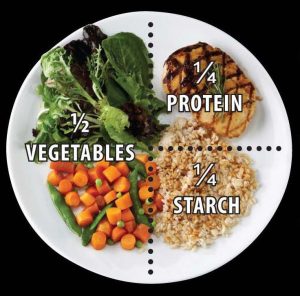- 8 March 2024
- 425
Balanced Nutrition: Building a Healthy Plate Made Simple

Understanding Balanced Nutrition
In today’s fast-paced world, maintaining a balanced diet can feel like an overwhelming task. With so much conflicting information and fad diets flooding the internet, it’s easy to feel lost when it comes to making healthy food choices. However, mastering balanced nutrition and Building a Healthy Plate doesn’t have to be complicated. By focusing on simple principles and incorporating a variety of nutrient-rich foods into your meals, you can achieve optimal health and vitality. In this comprehensive guide, we’ll explore the fundamentals of balanced nutrition and provide practical tips for creating nutritious and satisfying meals.
Balanced nutrition is essential for supporting overall health and well-being. It involves consuming a variety of foods that provide essential nutrients, including carbohydrates, proteins, fats, vitamins, and minerals, in appropriate proportions. These nutrients play vital roles in maintaining bodily functions, supporting growth and development, and preventing chronic diseases. Explore More About Health Issues and Their Solutions (How To Improve You Health in 30 Days)

The Importance of Macronutrients to Building a Healthy Plate
Macronutrients, including carbohydrates, proteins, and fats, are the primary sources of energy for the body. Each macronutrient serves a unique purpose:
Carbohydrates
Carbohydrates are the body’s primary source of energy. They provide fuel for essential bodily functions and physical activity. Whole grains, fruits, vegetables, and legumes are excellent sources of complex carbohydrates, which provide sustained energy and support overall health with Building a Healthy Plate.
Proteins
Proteins are essential for building and repairing tissues, supporting immune function, and producing enzymes and hormones. Incorporating a variety of protein sources such as lean meats, poultry, fish, eggs, dairy products, legumes, and nuts into your diet ensures that you meet your body’s protein needs.
Fats
Despite their bad reputation, fats are crucial for optimal health. They provide energy, support cell growth, protect organs, and aid in the absorption of fat-soluble vitamins. Opt for healthy fats from sources such as avocados, nuts, seeds, olive oil, and fatty fish to promote heart health and overall well-being.
Micronutrients and Phytonutrients
In addition to macronutrients, micronutrients such as vitamins and minerals are essential for various physiological functions. These micronutrients act as cofactors for enzymatic reactions, support immune function, and contribute to overall health. Additionally, phytonutrients found in plant-based foods possess antioxidant and anti-inflammatory properties, further enhancing the nutritional value of your diet.

Building a Healthy Plate
Creating a healthy plate involves balancing macronutrients and incorporating a variety of nutrient-dense foods into your meals. Follow these simple guidelines to build a balanced and nourishing plate:
Fill Half Your Plate with Vegetables and Fruits
🥦🍎 Vegetables and fruits are rich in vitamins, minerals, fiber, and antioxidants. Aim to fill half of your plate with a colorful array of vegetables and fruits to boost nutrient intake and promote satiety. Choose a variety of options such as leafy greens, peppers, tomatoes, berries, and citrus fruits to maximize nutritional benefits to Building a Healthy Plate.
Include Lean Proteins
🍗🥚 Incorporate lean sources of protein into your meals to support muscle health and promote feelings of fullness. Opt for skinless poultry, fish, tofu, tempeh, legumes, and lentils as nutritious protein options. Experiment with different cooking methods such as grilling, baking, or stir-frying to add flavor and variety to your meals.
Choose Whole Grains to Building a Healthy Plate
🌾 Swap refined grains for whole grains to increase fiber intake and stabilize blood sugar levels. Whole grains such as brown rice, quinoa, barley, oats, and whole wheat pasta provide essential nutrients and promote digestive health with Building a Healthy Plate. Incorporate whole grains into your meals as a source of complex carbohydrates to sustain energy levels throughout the day.
Incorporate Healthy Fats To Building a Healthy Plate
🥑🥜 Include sources of healthy fats in your diet to support heart health and enhance flavor. Add avocado slices, nuts, seeds, and olive oil to salads, stir-fries, and whole grain dishes to boost nutrient absorption and satiety. Be mindful of portion sizes to control calorie intake while enjoying the benefits of healthy fats.
Practice Portion Control
🍽️ Maintaining portion control is key to preventing overeating and achieving weight management goals. Use smaller plates, bowls, and utensils to help control portion sizes and avoid excess calorie consumption. Pay attention to hunger and fullness cues, and eat mindfully to savor each bite and prevent mindless eating.

Additional Tips for Healthy Living
In addition to building a healthy plate, incorporating the following habits into your lifestyle can further support overall well-being:
1. Eat Breakfast
Starting your day with a nutritious breakfast jumpstarts your metabolism and provides energy for the day ahead. Aim for a balanced meal that includes protein, carbohydrates, and healthy fats to keep you satisfied and focused until your next meal.
2. Enjoy Your Food
Savoring each bite and practicing mindful eating can enhance the enjoyment of meals and promote better digestion. Take the time to appreciate the flavors, textures, and aromas of your food, and eat slowly to allow your body to register feelings of fullness.
3. Get Enough Sleep
Prioritizing quality sleep is essential for overall health and well-being. Aim for seven to nine hours of uninterrupted sleep each night to support cognitive function, mood regulation, and immune health.
4. Reduce Sugar
Limiting intake of added sugars can help prevent weight gain, reduce inflammation, and lower the risk of chronic diseases such as obesity, type 2 diabetes, and heart disease. Opt for natural sweeteners such as fruit or choose products with no added sugars whenever possible.
5. Stay Hydrated
Drinking an adequate amount of water throughout the day is crucial for maintaining hydration, supporting bodily functions, and promoting healthy skin. Aim to drink at least eight glasses of water daily, and hydrate with herbal teas, infused water, or electrolyte-rich beverages as desired.
6. Choose Lean Proteins
Opting for lean protein sources such as poultry, fish, tofu, and legumes can help reduce saturated fat intake and support heart health. Incorporate a variety of lean proteins into your meals to ensure adequate intake of essential amino acids and promote muscle growth and repair.

Understanding Mindful Eating Habits
🍽️ Present Moment Awareness
Mindful eating encourages being fully present during meals, allowing you to savor the flavors, textures, and aromas of your food. Instead of rushing through meals or eating on autopilot, take the time to notice the colors, shapes, and smells of your food, enhancing the dining experience.
👂 Listening to Your Body
Mindful eating involves tuning into your body’s hunger and fullness cues, rather than relying on external factors such as portion sizes or meal times. By paying attention to sensations of hunger and satiety, you can eat when you’re truly hungry and stop when you’re satisfied, promoting better digestion and preventing overeating.
🧘♂️ Embracing Nonjudgmental Awareness
Mindful eating encourages a nonjudgmental attitude towards food and eating habits. Instead of labeling foods as “good” or “bad,” practice accepting all foods without guilt or shame. By cultivating self-compassion and letting go of food-related judgments, you can develop a healthier relationship with food and your body.
🧠 Mindful Eating Practices
Incorporating mindfulness techniques into your eating routine can help you develop mindful eating habits. Techniques such as mindful breathing, body scans, and mindful eating meditations can increase awareness of physical sensations and promote mindful eating. Experiment with different practices to find what works best for you.
😊 Reduced Emotional Eating
Mindful eating can help break the cycle of emotional eating by increasing awareness of emotional triggers and developing healthier coping strategies. Instead of using food to numb or distract from emotions, practice mindfulness to explore underlying feelings and respond to them with self-care and compassion.
🎉 Enhanced Enjoyment of Food
Mindful eating can enhance the enjoyment of food by allowing you to fully experience each bite. By slowing down and savoring the flavors and textures of your meals, you can derive greater pleasure from eating and feel more satisfied with smaller portions. Cultivate gratitude for the nourishment your food provides, fostering a positive and joyful relationship with eating.
Incorporating mindful eating habits into your daily routine can promote overall well-being and support a healthier relationship with food. By practicing present moment awareness, listening to your body’s cues, and embracing nonjudgmental awareness, you can cultivate a mindful approach to eating that nourishes both body and mind.
| Healthy Eating Habits | Unhealthy Eating Habits |
|---|---|
| Focus on whole, minimally processed foods | Rely on processed and convenience foods |
| Include a variety of fruits and vegetables | Lack of fruits and vegetables in diet |
| Incorporate lean protein sources | High intake of saturated and trans fats |
| Opt for whole grains | Consume refined grains and sugary cereals |
| Choose healthy fats from sources like avocado, nuts, and olive oil | Consume excessive amounts of fried foods and processed snacks |
| Practice portion control and mindful eating | Overeat and consume large portion sizes |
| Hydrate with water and herbal teas | Drink sugary beverages and excess alcohol |
| Prioritize nutrient density and balance | Consume foods high in added sugars, salt, and unhealthy additives |
Final Thoughts (Building a Healthy Plate)
Mastering balanced nutrition and building a healthy plate is achievable with the right knowledge and strategies. By incorporating a variety of nutrient-rich foods into your meals, practicing portion control, and adopting healthy lifestyle habits, you can support optimal health and well-being. Remember to listen to your body’s cues, prioritize whole, minimally processed foods, and enjoy the journey to better health.
FAQS: (Building a Healthy Plate)
Why is balanced nutrition important?
Balanced nutrition is essential for supporting overall health and well-being. It provides the body with essential nutrients needed for various physiological functions, promotes optimal growth and development, and helps prevent chronic diseases.
What are macronutrients, and why are they important?
Macronutrients, including carbohydrates, proteins, and fats, are the primary sources of energy for the body. They play crucial roles in providing fuel for essential bodily functions, supporting muscle growth and repair, and maintaining overall health.
How can I incorporate more vegetables and fruits into my diet?
You can incorporate more vegetables and fruits into your diet by aiming to fill half of your plate with these nutrient-rich foods. Choose a variety of colorful options and experiment with different cooking methods to enhance flavor and texture.
What are lean proteins, and why are they beneficial?
Lean proteins, such as poultry, fish, tofu, and legumes, are low in saturated fat and provide essential amino acids necessary for muscle growth and repair. Incorporating lean protein sources into your meals can help support overall health and promote feelings of fullness.
Why should I choose whole grains over refined grains?
Whole grains are rich in fiber, vitamins, and minerals, whereas refined grains have been stripped of their nutrient-rich bran and germ layers. Choosing whole grains over refined grains can help stabilize blood sugar levels, promote digestive health, and provide sustained energy.
What are healthy fats, and how can I incorporate them into my diet?
Healthy fats, such as those found in avocados, nuts, seeds, and olive oil, provide essential fatty acids and support heart health. You can incorporate healthy fats into your diet by using them in cooking, as toppings for salads, or as snacks.
How can I practice portion control?
Practicing portion control involves using smaller plates, bowls, and utensils to help control serving sizes. Additionally, paying attention to hunger and fullness cues, eating slowly, and avoiding distractions during meals can help prevent overeating.
Why is eating breakfast important?
Eating breakfast jumpstarts your metabolism, provides energy for the day ahead, and can help prevent overeating later in the day. Aim for a balanced breakfast that includes protein, carbohydrates, and healthy fats to keep you satisfied and focused.
How can I reduce my intake of added sugars?
You can reduce your intake of added sugars by choosing products with no added sugars, opting for natural sweeteners such as fruit, and reading food labels to identify hidden sources of sugar. Limiting sugary beverages and processed foods can also help lower sugar intake.
What are some tips for staying hydrated?
Staying hydrated is essential for maintaining overall health and well-being. You can stay hydrated by drinking water throughout the day, consuming hydrating foods such as fruits and vegetables, and avoiding excessive caffeine and alcohol intake. Aim to drink at least eight glasses of water daily and listen to your body’s thirst cues.

